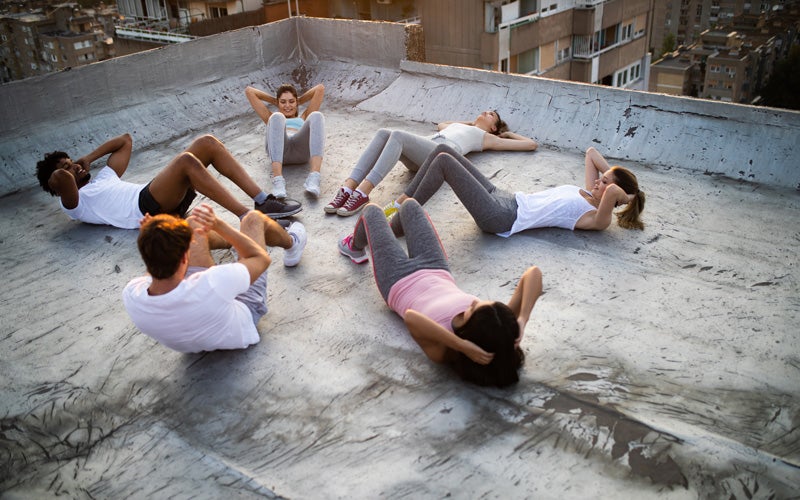7 Exercises for a Strong Core
 ©nd3000
©nd3000
Ever see someone who seems fairly normal, athleticism-wise, and then they absolutely crush everything they do? Run fast and far, knock out a HIIT workout, fly back and forth across a basketball court or football pitch? Obviously they have a good baseline fitness. And if they’re a jack-of-all-trades athlete, they have probably done some serious work on their core.
Why is the core so important?
The core muscles stabilize and hold the trunk, also known as the torso. Anatomically, this consists of the thorax, chest, abdomen, back and pelvis. Many small muscles, both superficial and deep, run through this central portion of the body. Not to sound tautological, but the core is at the core of everything you do. It keeps your body upright when you’re walking or sitting, and it takes pressure off your back muscles, spine, and other ligaments. Engaging your core allows glutes and leg muscles to function properly, and same for the upper body. Like to play softball, tennis or golf? You’re able to rotate through the swings — and even catch yourself when you’re off balance — thanks in large part to your excellent core.
Furthermore, people who are prone to lower back issues, a weak core is sometimes a contributing culprit. Which is why, when you are laid up with a back injury, a physician might tell you to heal the immediate problem, and then for long-term care, hit the gym with a back-relief-focused core workout. For athletes, regardless of whether they are focused on strength, endurance, or a mix of both, a lacklustre core usually translates into reduced performance. Any surfers out there? An eight-week core strength training program may help competitive surfers at their sport, found researchers in Southern California (of course).
Related: Best ab exercises for a smoking core
A few more pros to a strong midsection:
You’ll run faster: A strong torso improves the interaction between the pelvis, hips and lower back, benefitting runners.
You’ll improve arm and leg strength: Your core is connected to the extremities and acts to transmit power.
You’ll achieve more flexibility: The stronger the entire trunk musculature, the less pressure there is on individual tendons, joints and ligaments, especially in the lower body. As a result, your movements are smoother and you are more flexible.
You’ll be more agile as you age: Your core muscles are largely responsible for your balance and coordination skills. Both decrease with age. If you start core training early, you can later move and act more independently.
It’s also nice to be able to lift a bag of cat litter or an overstuffed suitcase out of the boot of your car — and those movements rely on good core strength. (And that you lift with your legs!)
Your body is more than muscles. Learn what it needs here!
How to train the core
Its interconnectedness to the rest of the body means that whatever movements you are doing, you’re probably also training your core. Even exercises that focus on arm strength always involve parts of the core muscles as well. To strengthen all parts evenly and purposefully, you should observe four principles:
Alternate between static exercises like planks and dynamic exercises like squats, crunches, or jumping jacks.
Related: See how many calories you’ll burn with this exercise chart
Incorporate exercises that cover all three planes of movement—sagittal (which divides the body lengthwise from the top of your skull to your feet), transverse (which divides the body top and bottom with the waist as the halfway point) and frontal (front vs. back). A good combination are, for example, crunches, Russian twists and side plank crunches.
7 exercises to do at home
These can be done at the gym or in your home — assuming you have some basic equipment. Dumbbells, a weight plate, or a sandbag will do. Turn this into a 12-minute core workout. For the first six movements, work for 30 seconds, resting for as little time as possible between movements. For the seventh move, perform it slowly, taking up to 1 minute, and use the remaining time for rest. Repeat twice.
- Single Arm Plank
Start in a high plank, hands under shoulders, a straight line between heels and head. Without allowing your hips to rotate, lift left arm and point fingers ahead and up, then replace arm and switch sides. The higher you hold your hand, the more it activates the core muscles.
- Plank Jacks
Start in a low plank, forearms on floor, a straight line between heels and head. Engage core and glutes and jump feet out, then jump them back to start. Continue jumping without letting hips rise.
Refuel: Try our whey protein either before or after exercising.
- Front jumping jacks
Start standing, feet wider than hip-width apart, arms extended to sides, palms forward, then jump legs together and palms together at the same time, keeping arms and legs straight, then return to start. Keep jumping quickly.
- Squat bicycle crunches
Start standing with feet hip-width apart, elbows high, fingertips near temples, palms facing out. Drop into a squat, then stand and draw your left knee up and to the right, and right elbow down and to the left, so the left knee and right elbow meet. Reverse to start, drop into a squat, and rotate and crunch on the opposite side. Continue squatting and crunching, switching sides.
- Side lunges
Stand with feet hip-width apart. In one smooth movement, lift the right foot and, keeping left foot straight, place right foot wide and drop into a squat over right leg, knee tracking over ball of right foot, hands lightly together and in front of body as a counterbalance. Reverse to start and repeat on the left side.
These supplements will keep your body on tip-top form.
- Walking lunges
Start with feet hip-width apart, hands on hips. Step left foot forward into a lunge, left foot tracking over ball of left foot, right knee lightly tapping floor, then press through left foot and step right foot forward. Repeat on the right side. If that’s too hard, do standing reverse lunges, or do standing lunges and place a cushion under your knees. If that’s too easy, do walking lunges holding a weight plate over your head.
- Single-leg deadlift
Start with feet hip-width apart, a dumbbell in each hand. Keeping core tight, with shoulder blades together and down, shift weight to left foot, then lift right foot, and tip torso forward while extending right leg back, until leg and torso are close to horizontal. Reverse to start. Do 3-4 reps on left foot, then switch sides.
More healthy living tips from foodspring:
- More performance in the gym through mobility training
- The #1 Reason Your Muscles Aren’t Growing
- 6 Surprising Effects Lifting Weights, According to Science
- Push & Pull – The Only 6 Moves Your Need to Know to Build Strength
Sources for this article
We at foodspring use only high-quality sources, including peer-reviewed studies, to support the facts within our articles. Read our editorial policy to learn more about how we fact-check and keep our content accurate, reliable, and trustworthy.






















